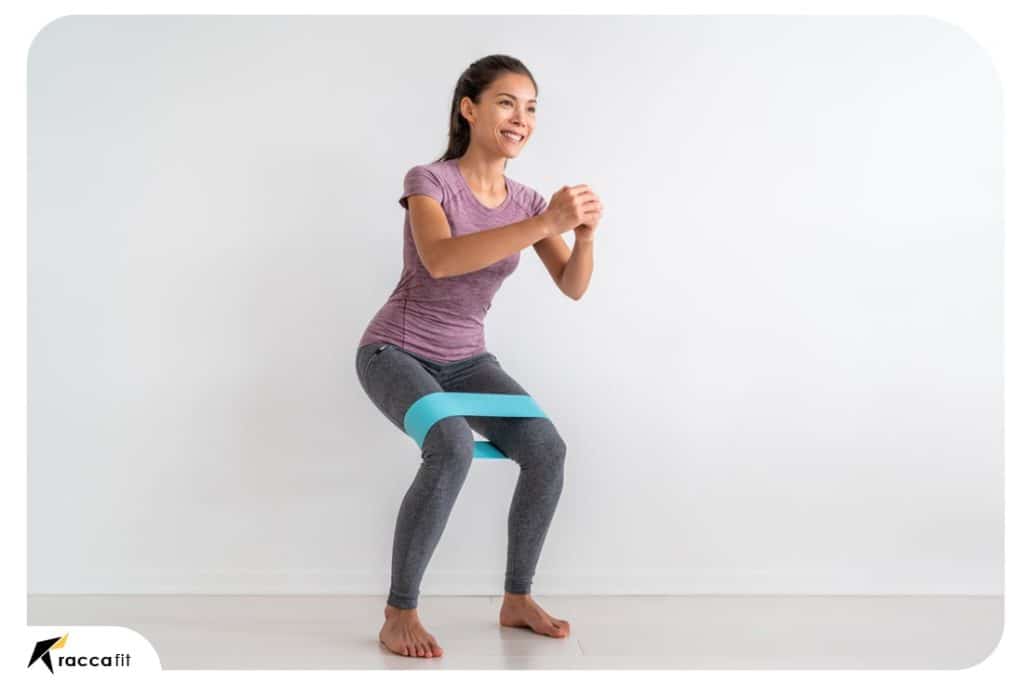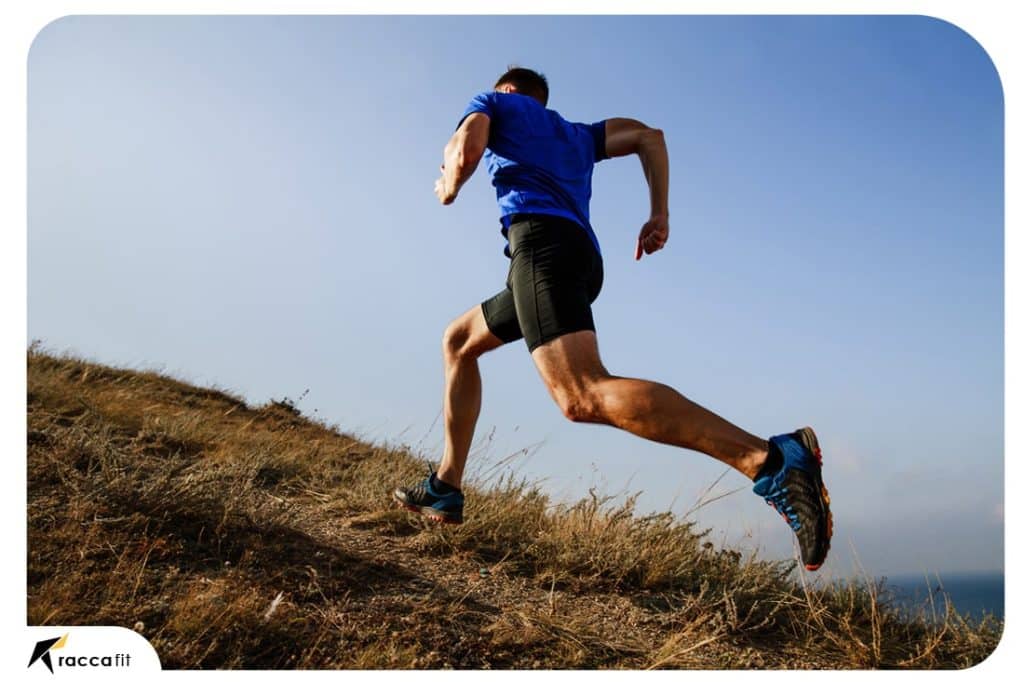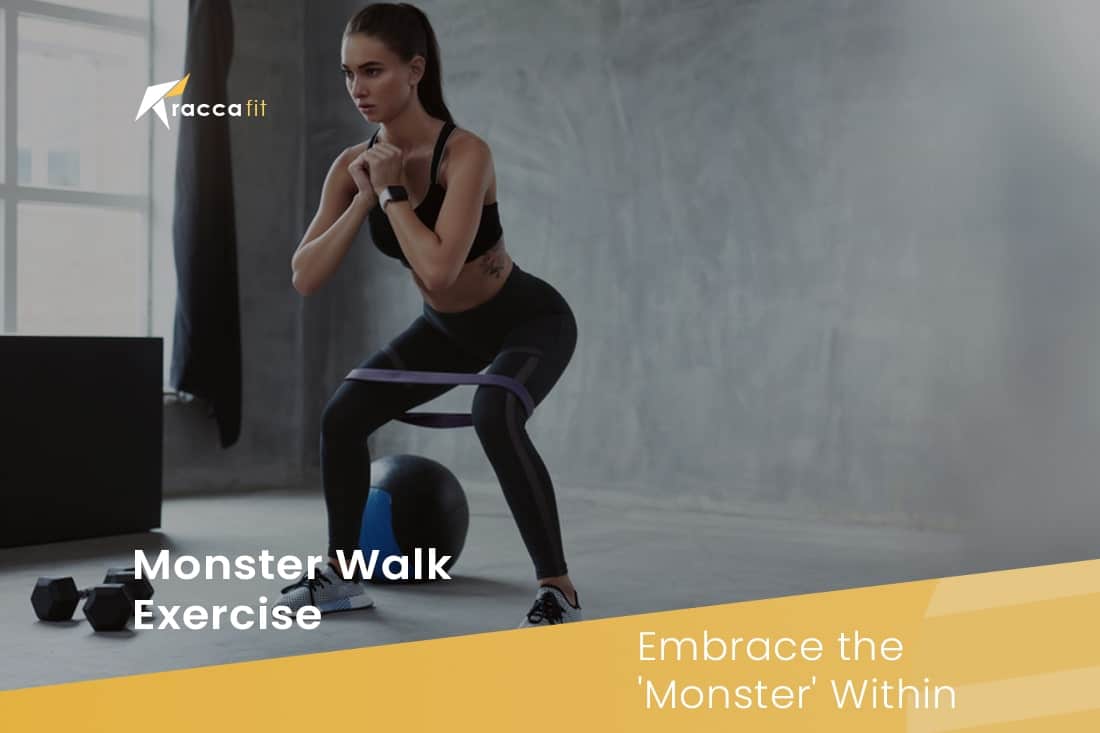The Monster Walk exercise is a lesser-known yet highly effective lower-body workout that has been gaining popularity in recent years. This exercise, which might sound intimidating but is quite approachable, is an excellent addition to your fitness routine for a variety of reasons.
Introduction to the Monster Walk Exercise
Monster Walks are a functional exercise designed to target the muscles in your hips and glutes. It gets its name because, when done correctly, the movements mimic a creature’s gait, hence the “monster” in the title. The Monster Walk exercise might appear peculiar, but it’s a fantastic way to work on specific muscle groups while improving your overall mobility and stability.
These exercises offer a fun and challenging way to improve lower body strength. They are often recommended by fitness trainers and physical therapists alike. If you’re looking to diversify your exercise routine, target your hip and glute muscles, or simply try something new, the Monster Walk is worth considering.
Benefits of Monster Walk Exercise
1. Strengthening Hips and Glutes
The primary benefit of Monster Walks is the development of hip and glute muscles. These muscles play a crucial role in maintaining stability, posture, and power in various physical activities.
Monster Walks engage the hip abductors, including the gluteus medius and minimus, to a great extent. This targeted work leads to improved strength in these muscle groups. Strong hip and glute muscles contribute to better athletic performance and can help alleviate lower back pain.
2. Hip Mobility
The Monster Walk exercise can significantly enhance hip mobility, which is vital for a wide range of physical activities and overall comfort in daily life. Improved hip mobility means you can move with greater ease and less discomfort. This is especially beneficial for older adults who want to maintain their independence and range of motion.
3. Injury Prevention
By strengthening the hips and glutes, you can reduce the risk of injuries, especially in the lower back and knees. This exercise helps to stabilize these areas, promoting better overall joint health.
Moreover, enhanced hip and glute strength contributes to better spinal support. A strong lower back, in combination with strong hips and glutes, can help reduce the risk of common issues like sciatica and herniated discs.
The Monster Walk can be an excellent addition to your routine if you’re prone to lower back pain or want to prevent such issues from arising.

How to Properly Perform Monster Walk Exercise
Getting Started
To perform Monster Walks, you’ll need some space and possibly a resistance band. Here’s how to get started:
- Stand with your feet hip-width apart.
- Place a resistance band around your ankles. The band should have some resistance but not be overly tight.
- Bend your knees slightly and maintain a slight forward lean from your hips.
Correct Form and Posture
Maintaining the right form is crucial when performing Monster Walks. Follow these steps:
- Begin by taking a step to the side with one foot, keeping tension on the band.
- Follow with the other foot.
- Repeat this sidestepping motion for about 10-15 steps in each direction.
Proper form is essential to ensure you target the right muscles and prevent unnecessary strain. Keep these tips in mind:
- Maintain a slight bend in your knees throughout the exercise.
- Avoid letting your knees collapse inward.
- Keep your feet parallel and your toes pointing forward.
- Engage your core to maintain balance and stability.
By performing Monster Walks with the right form and posture, you can maximize the effectiveness of this exercise.
Learn More: Metabolic Confusion Diet Plan: A Metabolic Revolution
Incorporating Monster Walk Exercise into Your Workout Routine
Monster Walks can be incorporated into your workout routine in various ways. We can help you to build a workout plan tailored to your goals, preferences, schedule, and available equipment in this page but here are some ideas:
- Warm-up: Use Monster Walks as part of your warm-up routine to activate your glutes and hips before more intense exercises. This helps prepare your muscles for the workout ahead and reduces the risk of injury.
- Strength Training: Include Monster Walks in your lower-body strength training routine for added resistance and muscle engagement. You can do this by increasing the tension on the resistance band or using a heavier band.
- Rehabilitation: These exercises are often used in physical therapy and rehabilitation programs to help patients recover from injuries. If you’re rehabilitating from a hip or lower back injury, consult with a healthcare professional or physical therapist to determine the most suitable Monster Walk routine for your needs.
- Cardio Workouts: Incorporate Monster Walks into your cardio routine by doing them between cardio intervals. This provides a full-body workout while keeping your heart rate up.
- Sports Conditioning: Athletes in sports that require lateral movements, such as basketball or tennis, can benefit from Monster Walks. These exercises can improve agility, lateral quickness, and overall performance on the field or court.
Variations of Monster Walks
Sideways Monster Walks
While the standard Monster Walks involve moving laterally, you can also perform them by moving forward and backward, providing an additional challenge to your muscles. This variation can target slightly different muscle groups, offering a well-rounded lower-body workout.
To perform forward and backward Monster Walks:
- Start with the resistance band around your ankles.
- Instead of taking steps to the side, move forward with one foot and then the other.
- After a few steps in one direction, switch to moving backward.
By adding forward and backward Monster Walks to your routine, you can engage different muscle fibers and keep your workouts fresh and exciting.

Monster Walks with Resistance Bands
Introducing resistance bands to Monster Walks increases the difficulty of the exercise, making it more effective in building strength and muscle. Resistance bands come in various levels of tension, allowing you to gradually increase the challenge as you become more proficient.
To perform Monster Walks with a resistance band:
- Step into the resistance band, placing it just above your ankles.
- Stand with your feet hip-width apart.
- Perform Monster Walks as usual, taking steps to the side while maintaining tension on the band.
Using a resistance band provides consistent resistance throughout the exercise, targeting your hip abductors more effectively. As your strength improves, you can switch to a band with greater resistance to continue challenging your muscles.
Common Mistakes to Avoid
To reap the full benefits of Monster Walks, you should be aware of and avoid common mistakes, such as:
- Allowing the knees to collapse inward: This can lead to knee strain and diminish the effectiveness of the exercise. Focus on keeping your knees aligned with your feet.
- Not maintaining tension on the resistance band: To work the hip abductors effectively, you must keep the band taut throughout the exercise.
- Overstepping or taking too wide a step: While it’s essential to challenge your muscles, taking overly wide steps can strain your knees and lower back. Stick to a comfortable range of motion, gradually increasing it as your strength improves.

Monster Walk Exercise for Specific Muscle Groups
Glute Activation
Monster Walks are particularly effective at targeting the glute muscles. The gluteus medius, in particular, is heavily engaged during this exercise. The activation of the glutes can help you achieve a firmer and more sculpted backside.
Strong glutes not only contribute to a shapely appearance but also play a vital role in stabilizing the pelvis and supporting the lower back. By incorporating Monster Walks into your routine, you can effectively target and strengthen your glutes.
Hip Mobility
Improved hip mobility is crucial for various movements in everyday life, from picking up objects to maintaining proper posture. Many people experience hip tightness, which can lead to discomfort and limited range of motion. Monster Walks can help alleviate this issue by stretching and strengthening the hip abductors.
The hip abductors are responsible for moving your leg away from your body’s midline. By working on these muscles through Monster Walks, you can enhance your hip mobility, making daily activities more comfortable and enjoyable.
Monster Walk Exercise for Injury Prevention
Incorporating Monster Walks into your regular workout routine can help prevent injuries by strengthening the supporting muscles around your hips and lower back. This can be particularly beneficial for athletes and individuals engaged in physical activities that involve frequent lateral movements.
When your hip and glute muscles are strong, they provide better support to your spine and pelvis. This can significantly reduce the risk of lower back pain and injuries. Moreover, strong hips and glutes can help maintain proper knee alignment, reducing the chances of knee injuries.
Monster Walks are often recommended for individuals recovering from hip injuries or surgeries. The controlled, low-impact nature of this exercise makes it suitable for rehabilitation purposes. However, always consult with a healthcare professional or physical therapist before incorporating any new exercises into your rehabilitation routine.
Learn More: Benefits of Running: Why It’s One of the Best Forms of Exercise
Monster Walk Exercise for Enhanced Athletic Performance
Monster Walks are not just for fitness enthusiasts; they are also a valuable tool for athletes looking to enhance their performance. The exercises involved in Monster Walks can be tailored to specific sports and activities, making them a versatile addition to any athlete’s training regimen.
Improving Agility and Quickness
Athletes that need agility and rapid lateral movements can benefit most from monster walks. These workouts will improve your speed and accuracy whether you’re a soccer player, basketball player, or tennis fan.
Lateral strength and stability are essential in sports that involve sudden changes in direction, which is precisely what Monster Walks help to develop. By engaging the hip abductors and glute muscles, you improve your ability to accelerate and decelerate effectively, giving you an edge in sports that demand rapid lateral movement.
Preventing Sports-Related Injuries
Another significant advantage of incorporating Monster Walks into your athletic training is injury prevention. In sports with high-intensity movements, injuries are a real concern. Strong hip and glute muscles can act as a protective shield for your lower back, knees, and hips.
Athletes who perform Monster Walks consistently often experience fewer instances of knee and lower back injuries. The added stability in these crucial areas can mean the difference between a successful season and one spent on the sidelines.

Monster Walk Exercise for Runners: Benefits and Training Tips
Runners, in particular, can benefit from Monster Walks. While running primarily involves forward motion, lateral strength and stability are equally important for a balanced stride and injury prevention.
Incorporating Monster Walks into your running routine can help you build the hip strength necessary for better stability during each stride. It can also alleviate the risk of overuse injuries by promoting balanced muscle development.
For runners, Monster Walks can be an excellent complement to their training. Here are some training tips to get the most out of this exercise:
- Frequency: Aim to include Monster Walks in your routine two to three times per week. This consistency will help you build and maintain hip and glute strength.
- Integrate into Warm-ups: Perform Monster Walks as part of your warm-up routine. This helps activate your glutes and hips, preparing them for the demands of running.
- Vary Intensity: You can increase the intensity by using a stronger resistance band or increasing the range of motion. However, be cautious not to overexert yourself, especially if you’re new to this exercise.
- Balance with Other Exercises: Combine Monster Walks with other lower body exercises, such as squats and lunges, for a comprehensive leg workout.
- Consult a Professional: If you’re a serious runner or have a history of running-related injuries, consider consulting a running coach or physical therapist. They can help you create a customized training plan that incorporates Monster Walks for maximum benefit.
By following these tips and incorporating Monster Walks into your running regimen, you can improve your running performance and reduce the risk of common running injuries.
Monster Walk Exercise for Seniors: Maintaining Mobility and Independence
As we age, maintaining mobility and independence becomes increasingly important. Seniors can also benefit from Monster Walks, as these exercises help enhance hip strength and mobility, ultimately improving overall quality of life.
Benefits for Seniors
The advantages of Monster Walks for seniors are manifold. Here are some key benefits:
- Enhanced Stability: Improved hip strength and balance can prevent falls, a significant concern for older adults.
- Increased Independence: By maintaining mobility and strength, seniors can continue to perform daily tasks and activities without relying on assistance.
- Enhanced Quality of Life: Being able to move comfortably and independently is crucial for seniors to enjoy a high quality of life.
Incorporating Monster Walk Exercise into a Senior Fitness Routine
If you’re a senior or a caregiver for an older adult, consider these tips for integrating Monster Walks into a fitness routine:
- Start Gradually: Begin with basic Monster Walks and a light resistance band. Focus on proper form and build strength gradually.
- Consult a Professional: If you’re unsure how to perform Monster Walks safely, consult with a physical therapist or fitness trainer. They can provide guidance and ensure that you’re performing the exercises correctly.
- Regular Consistency: Aim for regular but manageable sessions. Even a few minutes of exercise can make a significant difference in the long run.
- Balance with Other Activities: Combine Monster Walks with other exercises and activities that promote overall health, such as gentle stretching and cardiovascular workouts.
Monster Walks can be a valuable addition to a senior fitness routine, helping older adults maintain their independence, mobility, and overall well-being.

Nutrition Tips for Maximizing the Benefits of Monster Walk Exercise
While exercise is a critical component of a healthy lifestyle, nutrition plays an equally vital role. In this page we can provide a plan customized to meet your exact nutritional needs, keep an eye for any food allergies, and create a meal plan no matter the dietary requirement but you can consider these nutrition tips to maximize the benefits of Monster Walks and support your overall fitness goals.
Hydration
For exercises to be effective, proper hydration is crucial. Your muscles work better and you’re less prone to become tired and cramp during activity when you’re properly hydrated. To be well hydrated, drink enough water both before and after your Monster Walks.
Balanced Diet
A well-rounded diet that includes a variety of nutrient-rich foods is essential for muscle recovery and overall health. Ensure you’re getting a mix of carbohydrates, proteins, and healthy fats to fuel your workouts and aid in muscle repair.
Protein for Muscle Recovery
Protein is crucial for muscle recovery and growth. After your Monster Walks, consider having a protein-rich snack or meal to support your muscles. Lean sources of protein, such as chicken, tofu, or legumes, can help you recover faster.
Nutrient Timing
The timing of your meals can impact your exercise performance. It’s generally a good idea to have a balanced meal a few hours before your workout. This will provide your body with the energy it needs to perform well. After your workout, aim to have another meal or snack within an hour to aid in recovery.
By paying attention to your nutrition and incorporating these tips into your routine, you can make the most of your Monster Walks and overall fitness regimen.
Incorporating Monster Walk Exercise into Home Workouts
Many people prefer working out at home for convenience and privacy. Fortunately, Monster Walks can be easily integrated into home workout routines without the need for elaborate equipment.
Creating a Home Workout Space
To incorporate Monster Walks into your home workouts, all you need is a small amount of space. A living room, bedroom, or even a backyard can serve as an excellent workout area.
Consider setting up a designated workout space with the following essentials:
- A yoga mat or exercise mat for added comfort and support.
- A resistance band of varying intensities to accommodate your fitness level.
- A mirror to check your form and posture during exercises.
- A water bottle for staying hydrated.
- A timer or fitness app to help you track your workout duration.
Monster Walk Routine at Home
Here’s a simple Monster Walk routine you can follow at home:
- Warm-up: Begin with a dynamic warm-up that includes light cardio exercises to elevate your heart rate. This can be jumping jacks, high knees, or jogging in place for about 5-10 minutes.
- Monster Walks: Perform Monster Walks for 10 to 15 minutes. Start with basic lateral movements, and as you become more comfortable, try forward and backward variations.
- Cool Down: Finish your Monster Walk routine with a cool-down that includes gentle stretching exercises. Focus on the muscles you’ve worked during the workout.
- Stay Hydrated: Remember to stay hydrated by sipping water throughout your workout.
By creating a home workout space and following a structured routine, you can enjoy the benefits of Monster Walks in the comfort of your own home.
Conclusion
In summary, the Monster Walk exercise is an excellent addition to your fitness routine. It offers numerous benefits, including strengthening the hips and glutes, improving hip mobility, and reducing the risk of injuries, especially in the lower back and knees. By incorporating Monster Walks into your workout regimen, you can enjoy the advantages of a stronger lower body and improved overall physical health.
So, whether you’re a seasoned athlete looking to enhance your performance, someone recovering from an injury, or simply someone who wants to stay active and healthy, the Monster Walk is a versatile and effective exercise you should consider adding to your fitness routine.
To get started with Monster Walks and experience these benefits for yourself, add this exercise to your workout regimen today.
FAQs
1. Are Monster Walks suitable for beginners? Yes, Monster Walks are suitable for individuals of all fitness levels. Start with basic movements and gradually increase the difficulty. If you’re new to exercising, begin with light resistance bands and short step ranges.
2. How often should I do Monster Walks? You can perform Monster Walks a few times a week as part of your regular workout routine. However, the frequency can vary depending on your fitness goals and other exercises in your routine. Consult with a fitness professional for personalized guidance.
3. Can I do Monster Walks without a resistance band? While resistance bands are often used, you can start without them and gradually add resistance as you become more comfortable with the exercise. Starting without a band allows you to focus on form and technique.
4. What muscles do Monster Walks target primarily? Monster Walks primarily target the glute and hip muscles. These exercises engage the gluteus medius and minimus, as well as the hip abductors. Targeting these muscle groups can lead to better stability, strength, and injury prevention.
5. Can Monster Walks help with lower back pain? Yes, strengthening the hips and glutes through Monster Walks can help alleviate lower back pain by providing better support to the spine. For those with chronic lower back pain, it’s essential to start with lighter resistance and consult a healthcare professional or physical therapist to ensure safe and effective rehabilitation.








